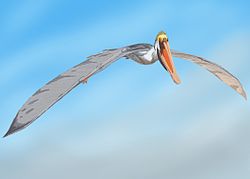| Istiodactylids Temporal range: Early Cretaceous, Possible Middle Jurassic record | |
|---|---|
 | |
| Life restoration of Istiodactylus latidens feeding on a stegosaur corpse. | |
| Scientific classification | |
| Kingdom: | Animalia |
| Phylum: | Chordata |
| Class: | Reptilia |
| Order: | † Pterosauria |
| Suborder: | † Pterodactyloidea |
| Clade: | † Pteranodontoidea |
| Clade: | † Lanceodontia |
| Clade: | † Istiodactyliformes |
| Family: | † Istiodactylidae Howse, Milner & Martill, 2001 |
| Type species | |
| † Ornithodesmus latidens Seeley, 1901 | |
| Genera | |
| |
Istiodactylidae is a small family of pterosaurs. This family was named in 2001 after the type genus Istiodactylus was discovered not to be a member of the genus Ornithodesmus .














